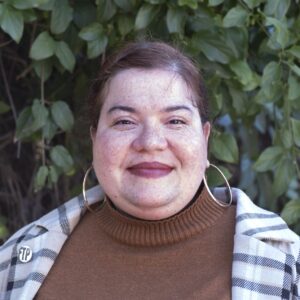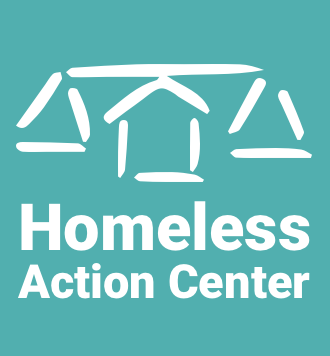Housing Justice Is Queer Power: From Stonewall to The Future

By Stefani Echeverria-Fenn, Mail Clerk & Front Office Coordinator at HAC
I spent my first pride month as an out lesbian working at my exploitative food service job, rolling burritos for wealthy tourists as the New York City pride parade marched past the store – so close and yet so far away. Knowing that I would return to a homeless shelter that night, this glossy, corporatized version of pride only made me feel more alone.
I should never have felt that way. The modern LGBTQIA+ liberation movement was created by unhoused and precariously housed people – the queer agenda has always been intertwined with housing justice and economic struggle. The 1969 Stonewall riots that birthed queer liberation as we know it today were largely the product of young, housing-insecure patrons for whom the Stonewall bar was a rare safe space. As Dick Leitsch, a gay journalist who covered the uprising, describes: “There are hundreds of young homosexuals in New York who literally have no home. . . . Many of them are running away from unhappy homes. . . . Some got thrown out of school or the service for being gay and couldn’t face going home. . . . The Stonewall became ‘home’ to these kids. When it was raided, they fought for it.”[i]
A year later, trans visionary Sylvia Rivera founded STAR House, a space in NYC’s Lower East Side for unhoused trans and gender non-conforming youth to crash. While the first iteration of STAR house lasted eight months before eviction, it inspired several future versions, including the youth shelters Transy House (1995-2008) and Sylvia’s Place (still open). As one account tells it: “The group which initially operated out of a trailer truck that had been seemingly abandoned in a Greenwich Village parking lot, fed and clothed dozens of youth . . . they relocated to Marsha [P. Johnson]’s apartment on East 2nd Street and paid the rent themselves so the younger ones didn’t have to panhandle or perform sex work. They hosted community meetings and political education for the gay and trans community every Friday night, and offered support for LGBTQ people who were arrested, as many of them often spent long periods in jail due to lack of funds to pay bails or fines.”[ii]
How many of the institutions that praise Sylvia Rivera today would seek to criminalize her for acts of economic survival?
More than 50 years after Stonewall, Sylvia Rivera’s name graces law projects, and corporations from Google to Netflix pay lip service to her activism. Yet, as Jessi Gan writes, so many of her “political affinities resist attempts to reduce her to appropriated symbol. Her life illustrates the limits of dominant theories of queer visibility, while her political commitments challenge us to continually bypass statically reductive visions of identity and community.”[i] How many of the institutions that praise Rivera today would seek to criminalize her for acts of economic survival such as petty shoplifting and survival sex work? How many would stigmatize her or deny her housing for drug and alcohol use?
As a formerly unhoused youth who experienced first-hand the gatekeeping of so many social service agencies that purport to help LGBTQ people, I came to my work at HAC with many suspicions of the nonprofit world. Yet, I have been heartened to see how HAC so radically embraces a model of harm reduction and low barriers to entry for its clients – how it holds room for the messy, complicated realities of unhoused people who are too often either vilified or canonized by larger cultural discourses. Homelessness is still a queer issue in a world where trans people are 18 times more likely to experience homelessness[ii] and 28% of LGBTQ youth have been unhoused. These numbers are even higher for LGBTQ people who are Black, Indigenous, Latinx, or multiracial and face intersectional barriers to housing.[iii] The Trevor Project notes that queer youth without stable housing are two to four times more likely to experience mental illness or attempt suicide – it is clear that housing is an issue of disability justice as well.
The Intersections of Housing, Queer Power, and Disability Justice
Though neither Rivera nor many of her STAR comrades, like Marsha P. Johnson, explicitly identified as disabled, so much of their work aligns with principles of disability justice that many HAC clients are living every day. For example, Stephan Cohen chronicles their protests against involuntary psychiatric incarceration in his work The Gay Liberation Youth Movement in New York: “STAR and others . . . alerted the community to the injustice perpetrated against adults and adolescents in prisons, mental institutions, and juvenile detention facilities. . . . Sylvia interviewed former dancer and aspiring dance therapist Chris Thompson, ‘a black male transvestite’ who sought treatment for asthma and was instead locked in Bellevue Hospital’s psychiatric wing. . . . Ensnared by ‘Catch-22’ regulations, Thompson’s incarceration stymied the very housing search critically needed to avoid transfer to a state mental hospital.”[i]
Cohen’s summation of the Orwellian bureaucratic systems one must navigate as a poor and disabled person is familiar to anyone who navigates them today. Today we romanticize STAR’s direct action in the streets, but this kind of lower-profile care work – writing to prisoners, providing food, providing support navigating systems – can be just as radical. The only reason I made it through college as an unhoused youth was the countless hours teachers spent helping me apply for scholarships, transfer credits, and do other paperwork that seemed “routine” but felt unsurmountable after the shock of my apartment burning down. I try to bring this same sense of care to my work with clients at HAC’s front desk – while helping someone get their birth certificate is not going to dismantle the systems oppressing us, it can knock down one hurdle on their path towards housing.
Holding space at HAC for brief service clients’ sadness, rage, and other emotions that capitalism encourages us to suppress in favor of narratives of progress helps me consider ways these emotions have the potential to deepen our struggles for justice. In Rivera’s most famous speech, she entreats the crowd not to forget the people who “are trying to do something for all of us, and not men and women that belong to a white middle class white club. And that’s what you all belong to!”[ii] Her voice is hoarse and furious – its cadences echo through the decades and remind me of the power and value in modes of resistance that refuse respectability politics.
What would it look like to reimagine a social safety net that could have kept Rivera alive – that could keep so many people still walking in her shoes alive today?
Rivera quit formal activism for decades shortly after this speech, exhausted by her constant marginalization as an unhoused Latinx trans femme even within the movement. Although she ultimately returned, she also spent years struggling with mental illness and addiction on the streets of New York City and died an untimely death at the age of 50. What would it look like to reimagine a social safety net that could have kept Rivera alive – that could keep so many people still walking in her shoes alive today? This June, the pride parade marched down Market Street, past the Walgreens where unhoused Black trans man Banko Brown was shot to death after a shoplifting confrontation.[i] To prepare for the 2022 pride march, San Francisco officials dismantled Civic Center’s sanctioned tent encampment.[ii] What would Rivera – who shoplifted food for her chosen kin and was banned from NYC’s LGBT Center for vociferously advocating that they let unhoused people sleep in their basement[iii] – have to say about this present reality?
What would Rivera have to say about CARE Court, a recently created California system of involuntary psychiatric treatment/conservatorship that HAC has publicly opposed? One of STAR’s first protests, a march to Bellevue Hospital, demanded “(1) An end to the oppression of homosexuals and all people in Bellevue Psychiatric Prison – the end of shock treatment, drugs, imprisonment, and mental poisoning. (2) Free medical care, dental care, and preventive medicine under community control . . .”[iv] HAC’s letter requesting review of Disability Rights California v. Gavin Newsom carries similar sentiments, noting that “We have also seen over our many decades of doing this work that forced treatment seldom, if ever, actually works. If someone is choosing to forego treatment, little can be done to force their adherence to a plan, including threat of incarceration or loss of liberty. Instead, forcing someone into treatment is inherently traumatizing and can even increase the severity of their illness and exacerbate the conditions keeping them in crisis and unhoused.”[v]
I myself have experienced involuntary psychiatric incarceration and I could not agree more. My mental health crises as a young person often stemmed from what felt like my fundamental disposability as a young queer person existing outside the bonds of the nuclear family and bio-reproductive kinship bonds. Studying the chosen families and liberatory networks of queer ancestors who walked this path before me has felt more healing than any therapist or medication and I hope that any unhoused LGBTQIA+ clients of HAC who may read this might also feel a little less alone knowing that so many of our queer heroes have struggled with meeting basic material needs – and that your survival as an unhoused queer/trans person is already revolutionary.
We are so far from Sylvia’s dreams of housing for all, but so many of us are also still fighting the good fight to get there. Some LGBT housing justice projects that particularly excite me in the Bay Area are listed below if you are looking for resources. Or, feel free to walk-in to HAC during our drop in hours – many of us HAC employees are queer and/or trans ourselves and we are always happy to help you look for resources beyond those listed here, make sure your name/pronouns are correct in our mail/case file system, and just generally be in community with you towards our shared liberation!
Resources
Our Trans Home SF (https://www.ourtranshomesf.org/) provides a short-term shelter, a longer-term supportive living house, housing vouchers, and advocacy and navigation services for trans and/or gender marginalized people. They’re predominantly staffed by trans people of color with lived experiences of economic marginalization themselves.
Openhouse (https://www.openhousesf.org/) serves LGBTQ seniors 55 and older and also maintains a list of affordable housing resources and housing navigation open to everyone here.
Jazzie’s Place, part of Dolores Street Community Services, operates a LGBT-specific shelter that is currently transitioning to a hotel site but should reopen soon – instructions on how to access it can be found here: https://hsh.sfgov.org/wp-content/uploads/2016/11/Jazzies_Place_Waitlist_Document_6-17-2015.pdf
Taja’s Coalition (https://tajascoalition.org/) helps trans people navigate emergency shelter systems and sometimes provides hotel vouchers. In addition, they fight for greater housing resources for trans people, especially trans women of color, on a policy level.
The Oakland LGBTQ Community Center (https://www.oaklandlgbtqcenter.org/housing-homeless-resources) maintains a list of safe housing and job opportunities and also sometimes has emergency grants available for queer/trans people behind on their rent or in danger of being evicted.
[i] https://www.kron4.com/news/bay-area/sf-supervisors-call-banko-brown-death-an-execution/
[ii] https://sfstandard.com/public-health/homeless-village-shutdown-pride/
[iii] C.f. https://znetwork.org/zmagazine/sylvia-rivera-1951-2002-by-michael-bronski/ and https://www.vice.com/en/article/z3enva/star-house-sylvia-rivera-marsha-p-johnson
[iv] https://transreads.org/wp-content/uploads/2022/03/2022-03-02_621f8bad5fe91_stephan-cohen-the-gay-liberation-youth-movement-in-new-york-an-army-of-lovers-cannot-fail-1.pdf (P 122)
[v] Amicus Letter of the Homeless Action Center, Request for Review of Disability Rights California v. Gavin Newsom (S278330) February 16th, 2023
[i] https://transreads.org/wp-content/uploads/2022/03/2022-03-02_621f8bad5fe91_stephan-cohen-the-gay-liberation-youth-movement-in-new-york-an-army-of-lovers-cannot-fail-1.pdf (page 136)
[ii] https://www.youtube.com/watch?v=Jb-JIOWUw1o
[i] https://go.gale.com/ps/i.do?p=AONE&u=googlescholar&id=GALE|A288980035&v=2.1&it=r&sid=AONE&asid=a6e9f0f6
[ii] https://www.ourtranshomesf.org/
[iii] https://www.thetrevorproject.org/research-briefs/homelessness-and-housing-instability-among-lgbtq-youth-feb-2022/
[i] https://www.theatlantic.com/politics/archive/2013/01/an-amazing-1969-account-of-the-stonewall-uprising/272467/
[ii] https://www.liberationschool.org/our-armies-are-rising-sylvia-rivera-and-marsha-p-johnson/
